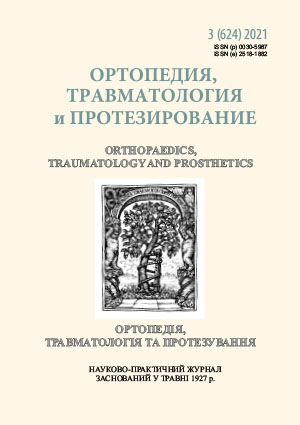OUR EXPERIENCE IN HARDING AND «BIKINI» APPROACHES AT TOTAL HIP ARTHROPLASTY
DOI:
https://doi.org/10.15674/0030-59872021354-58Keywords:
Total hip arthroplasty, hip joint, surgical accesses, blood loss, functional resultAbstract
Total hip arthroplasty is widely spread in all over the world medical practice. Different approaches are used for that procedure. Objective. To analyze the advantages and disadvantages of` «Bikini» approach
and compare them to the Harding approach in patients after total hip arthroplasty. Methods. Тhe results of treatment of 108 patients were retrospectively analyzed: 41 patients were operated with «Bikini» approach, 67 — with Harding approach. Total hip implant with ceramic-on-ceramic, ultra-high molecular weight polyethylene-
on-ceramic, and ultra-high molecular weight polyethylene-onmetal movement pair were used, also were used both cemented and cementless types of fixation. Results were evaluated on 14 day and 3 months after the surgery by Harris scale. Results. 14-day of followup the average Harris score value in patients operated with Harding approach were 74.87 points, in patients operated with «Bikini
» approach — 80,55 points, on the 3rd month of follow-up period the Harris score was 78.24 and 83.9 respectively. Conclusions. Both evaluated approaches have their own advantages and disadvantages, instruments and surgeon skills requirements. Proper utilization of the «Bikini» and Harding approaches provides good functional
results in early and late terms. «Bikini» approach requires a larger volume of preoperative preparation. The absence of fascia lata and
periarticular muscles injury due to the «Bikini» approach usage allows reducing of narcotic analgesics prescriptions, intraoperative blood loss and duration of walking with crutches. Good cosmetical scars effects are achieved by the parallelism of skin incision relatively to Langer’s lines. In the early postoperative period the better functional results were marked, early rehabilitation and mild pain syndrome allow to reduce hospital length of stay. The technical
complexity of the «Bikini» approach requires operations number more than 30 per year.
References
- Learmonth, I. D., Young, C., & Rorabeck, C. (2007). The operation of the century: Total hip replacement. The Lancet, 370(9597), 1508-1519. https://doi.org/10.1016/s0140-6736(07)60457-7
- Wolford, M. L., Palso, K., & Bercovitz, A. (2015). Hospitalization for total hip replacement among inpatients aged 45 and over: United States, 2000–2010. NCHS data brief, 186, 1–8.
- Sloan, M., & Sheth, N. P. (2018). Changing demographics in primary and revision total joint arthroplasty, 2000–2014. American Academy of Orthopaedic Surgeons 2018 Annual Meeting. Available from: http://submissions.mirasmart.com/Verify/AAOS2018/Submission/out/AAOS 2018-005902.PDF
- Korzh, M. O., Filipenko, V. A., & Tankut, V. O. (2012). Current state of the problem of joint arthroplasty in Ukraine. Pain. Joints. Spine, 1(5), 48–50. [in Ukrainian]
- Urrutia, J., Zamora, T., & Klaber, I. (2017). Hip fracture in the elderly. Clinical Medicine Insights: Geriatrics, 10(0). https://doi.org/10.1177/1179553017703998
- (2018). American Joint Replacement Registry 2018 Annual Report. Available from: http://connect.ajrr.net/2018-annual-report-download.
- Hofmann, A. A., & Skrzynski, M. C. (2000). Leg-length inequality and nerve palsy in total hip arthroplasty: a lawyer awaits! Orthopedics, 23(9), 943–944
- Pogliacomi, F., Paraskevopoulos, A., Costantino, C., Marenghi, P., & Ceccarelli, F. (2012). Influence of surgical experience in the learning curve of a new approach in hip replacement: Anterior mini-invasive vs. Standard lateral. HIP International, 22(5), 555-561. https://doi.org/10.5301/hip.2012.9710
Downloads
How to Cite
Issue
Section
License

This work is licensed under a Creative Commons Attribution 4.0 International License.
The authors retain the right of authorship of their manuscript and pass the journal the right of the first publication of this article, which automatically become available from the date of publication under the terms of Creative Commons Attribution License, which allows others to freely distribute the published manuscript with mandatory linking to authors of the original research and the first publication of this one in this journal.
Authors have the right to enter into a separate supplemental agreement on the additional non-exclusive distribution of manuscript in the form in which it was published by the journal (i.e. to put work in electronic storage of an institution or publish as a part of the book) while maintaining the reference to the first publication of the manuscript in this journal.
The editorial policy of the journal allows authors and encourages manuscript accommodation online (i.e. in storage of an institution or on the personal websites) as before submission of the manuscript to the editorial office, and during its editorial processing because it contributes to productive scientific discussion and positively affects the efficiency and dynamics of the published manuscript citation (see The Effect of Open Access).














